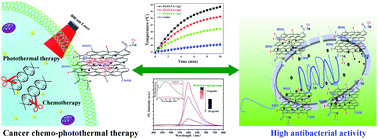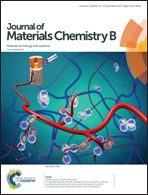Fluorescence turn-off Ag/fluorinated graphene composites with high NIR absorption for effective killing of cancer cells and bacteria†
Abstract
The unique structure and special chemical surface make fluorinated graphene–silver (FG–Ag) hold great promise in many biological fields. However, the synthesis of this nano-composite has not yet been achieved mostly due to the strong hydrophobicity and inertness of C–F bonds. Herein, we demonstrate an interesting concept of multifunctional FG–Ag and integrate it as a highly effective targeted drug carrier, photothermal therapy (PTT) and antibacterial agent. To achieve this, the F-sacrificing method is first employed to enrich FG with oxygen groups (FGO), which then serve as necessary and active reaction sites for controlled deposition of Ag nanoparticles (AgNPs) and modification of cancer targeting molecules. Interestingly, AgNPs well quench FGO's fluorescence, and FGO–Ag then acts as another effective quencher for the anticancer drug doxorubicin, all of which guarantee it as a novel sensor to visually monitor drug loading by “turn-off” fluorescence. More importantly, this nano-composite also possesses special targeting toward cancer cells; it exhibits high near-infrared absorption for PTT and shows effective antibacterial activity. This study establishes FGO–Ag as a novel nanocarrier with good targeting efficiency, high NIR absorption and drug loading and demonstrates its first application in antibacterial and cancer chemo-photothermal treatments.

- This article is part of the themed collection: International Year of the Periodic Table: Precious metals for cancer treatment


 Please wait while we load your content...
Please wait while we load your content...